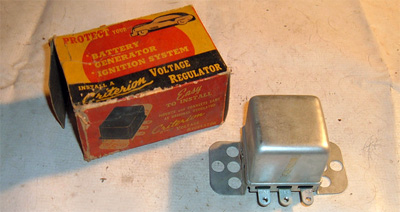For many car buffs, NOS (New Old Stock or New Original Stock) is the Holy Grail of auto trim. To those of this school of thought, I apologize for the following critical assessment. While it can be the finest solution to finding or replacing a part, extreme caution must be used. NOS parts are often factory seconds, and like all automotive parts, they are made by a range of suppliers. There is no guarantee that an NOS part will provide a proper fit, even if it is in its original packaging. As owner and operator of a stainless, aluminum, and pot metal restoration shop, I have a straightforward point to make: when restoring, use the part on your car whenever possible.
 As a youngster, I visited the Ford plant to see how the 1957 line was built. When they worked on trim, a piece was selected from a bin, briefly examined, and attached to a fender or door. If the piece did not fit correctly or attach easily, it was tossed into a reject bin. There is your NOS part.
As a youngster, I visited the Ford plant to see how the 1957 line was built. When they worked on trim, a piece was selected from a bin, briefly examined, and attached to a fender or door. If the piece did not fit correctly or attach easily, it was tossed into a reject bin. There is your NOS part.
When restoring my 1976 50th Anniversary Pontiac Trans Am, parts were still available from GM. I ordered the badges for the interior and exterior, repeatedly returning flawed items until I received an acceptable piece. Slightly flawed returns, or factory rejects, are typically repackaged and sold for collision repair or as replacement parts for the dealers. In other words, they become the hotly coveted NOS parts.
The trim that came on your car will fit the best. Remember that all major car manufacturers used several suppliers for the trim parts. The engineering specifications were sent to each, and it was up to the suppliers to make the parts. All have their idiosyncrasies, resulting in, for example, three distinctively different 1958 Chevy hub caps, and light housing casings on 1958 Pontiacs that vary by 40% in thickness.
NOS does not eliminate the need for restoration. After knocking around for forty or fifty years, many parts are scratched, dented, pitted, and/or bent. This is typically described as “shelf wear.” To prove my point, I have spent months collecting NOS parts. Of several dozen examples of stainless, aluminum, and pot metal pieces accumulated, there was only one that was without flaws, and that I would put on a car, right out of the box.
The emergence of the online dealers and auctions, while providing a convenient way to complete your car restoration, only increases the chances of acquiring a NOS part that needs as much work as your current trim. Most of my NOS study collection is from Ebay. Despite the descriptions and photographs illustrating “show quality,” i.e., that they were ready for assembly, 10% of what I purchased was better than expected, 40% was accurately depicted and priced accordingly, 40% contained more flaws that anticipated, and 10% was absurdly unacceptable. Expect to be disappointed half of the time.
Buying certain parts online or through the mail merits some additional comments. Often in the description of the aluminum or chrome-plated part, the seller will indicate that there is a minor scratch or a few minor scratches that can be “easily buffed out.” There is nothing easy about buffing out scratched, anodized aluminum. Nearly all aluminum automotive parts are anodized from the factory. Anodizing is accomplished by immersing the piece in a solution akin to battery acid while an electric current is passed through. The anodizing literally grows out of the surface of the aluminum. Initially, this is a very porous coating. It is “cured” by immersing the piece in boiling water. Any scratch on an anodized aluminum piece is impossible to buff out. The anodizing must be completely stripped by soaking the piece in a solution of caustic soda. The entire piece can then be sanded and polished in a uniform finish. You then have three options: re-anodize that piece, coat it with a clear urethane spray-on product, or leave it as is. (The only reason these pieces were originally anodized was to prevent the aluminum from oxidizing. If you do nothing with the piece, it will oxidize over a period of time. For the first couple of years, you would probably not notice this taking place. If you choose not to re-anodize or clear-coat your trim, simple polish it whenever you wax your car to keep your trim bright and chrome-like).
Most pot metal and steel pieces are triple plated with copper, nickel, and chrome. The final chrome plating is the thinnest plating of the three. If you try to polish out a scratch in a piece of chromed trim, you will polish through the chrome and down to the nickel, which has a yellow cast compared to the chrome. Nickel will oxidize at an alarming rate and even if you were to polish the nickel to match the chrome, within a few days it will change color. To remove any scratch from chrome trim, it must be re-plated, not buffed out. One final word of warning; there are two types of chrome plating: trivalent and hexavalent. Hexavalent is considered superior for show chrome because of its bluish hue. Trivalent chrome is less expensive to apply, and leave a colorless, harsher appearance. Most restored chrome pieces will be hexavalent, and may not match an original, un-restored chrome piece.
Use caution when buying any NOS trim parts. A quick and inexpensive fix is unlikely. Only go for the potentially problematic NOS part, usually in need of restoration, if you do not have an alternative.

